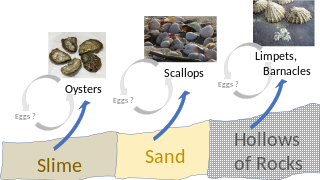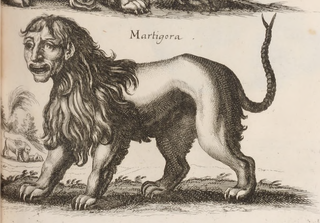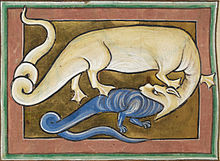
A bestiary is a compendium of beasts. Originating in the ancient world, bestiaries were made popular in the Middle Ages in illustrated volumes that described various animals and even rocks. The natural history and illustration of each beast was usually accompanied by a moral lesson. This reflected the belief that the world itself was the Word of God and that every living thing had its own special meaning. For example, the pelican, which was believed to tear open its breast to bring its young to life with its own blood, was a living representation of Jesus. Thus the bestiary is also a reference to the symbolic language of animals in Western Christian art and literature.

Crocodiles or true crocodiles are large, semiaquatic reptiles that live throughout the tropics in Africa, Asia, the Americas and Australia. The term “crocodile” is sometimes used more loosely to include all extant members of the order Crocodilia, which includes the alligators and caimans, the gharial and false gharial as well as other, extinct, taxa.

Spontaneous generation is a superseded scientific theory that held that living creatures could arise from nonliving matter and that such processes were commonplace and regular. It was hypothesized that certain forms, such as fleas, could arise from inanimate matter such as dust, or that maggots could arise from dead flesh. The doctrine of spontaneous generation was coherently synthesized by the Greek philosopher and naturalist Aristotle, who compiled and expanded the work of earlier natural philosophers and the various ancient explanations for the appearance of organisms. Spontaneous generation was taken as scientific fact for two millennia. Though challenged in the 17th and 18th centuries by the experiments of the Italian biologists Francesco Redi and Lazzaro Spallanzani, it was not discredited until the work of the French chemist Louis Pasteur and the Irish physicist John Tyndall in the mid-19th century.

An alligator, or colloquially gator, is a large reptile in the genus Alligator of the family Alligatoridae in the order Crocodilia. The two extant species are the American alligator and the Chinese alligator. Additionally, several extinct species of alligator are known from fossil remains. Alligators first appeared during the late Eocene epoch about 37 million years ago.

The manticore or mantichore is a legendary creature from ancient Persian mythology, similar to the Egyptian sphinx that proliferated in Western European medieval art as well. It has the face of a human, the body of a lion, and the tail of a scorpion or a tail covered in venomous spines similar to porcupine quills. There are some accounts that the spines can be launched like arrows. It eats its victims whole, using its three rows of teeth, and leaves no bones behind. Other accounts also have it sporting the wings of a dragon.

A cockatrice is a mythical beast, essentially a two-legged dragon, wyvern, or serpent-like creature with a rooster's head. Described by Laurence Breiner as "an ornament in the drama and poetry of the Elizabethans", it was featured prominently in English thought and myth for centuries. They are created by a chicken egg hatched by a toad or snake.

In medieval literature, the ichneumon or echinemon was the enemy of the dragon. When it sees a dragon, the ichneumon covers itself with mud, and closing its nostrils with its tail, attacks and kills the dragon. The ichneumon was also considered by some to be the enemy of the crocodile and the asp, and attack them in the same way. The name was used for the pharaoh's rat, mongoose, or Egyptian mongoose, which attacks snakes; it can also mean otter. The ichneumon is shaped similarly to a ferret, although much slimmer in its shape, and the head is elongated. Also, it is an animal that can move swiftly and is able to jump a couple of yards with a single leap.

The Nile crocodile is a large crocodilian native to freshwater habitats in Africa, where it is present in 26 countries. It is widely distributed in sub-Saharan Africa, occurring mostly in the eastern, southern, and central regions of the continent, and lives in different types of aquatic environments such as lakes, rivers, swamps and marshlands. It occasionally inhabits deltas, brackish lakes and rarely also saltwater. Its range once stretched from the Nile Delta throughout the Nile River. Lake Turkana in Kenya has one of the largest undisturbed Nile crocodile populations.

"Asp" is the modern anglicisation of the word "aspis", which in antiquity referred to any one of several venomous snake species found in the Nile region. The specific epithet, aspis, is a Greek word that means "viper". It is believed that aspis referred to what is now known as the Egyptian cobra.

Crocodile tears, or superficial sympathy, is a colloquial term used to describe a false, insincere display of emotion, such as a hypocrite crying fake tears of grief. The phrase derives from an ancient belief that crocodiles shed tears while consuming their prey and, as such, is present in many modern languages, especially in Europe, where it was introduced through Latin. While crocodiles do have tear ducts, they weep to lubricate their eyes, typically when they have been out of water for a long time and their eyes begin to dry out. However, evidence suggests this could also be triggered by feeding.

The salamander is an amphibian of the order Urodela which once, like many real creatures, often was suppositiously ascribed fantastic and sometimes occult qualities by pre-modern authors, as in the allegorical descriptions of animals in medieval bestiaries. The legendary salamander is often depicted as a typical salamander in shape, with a lizard-like form, but is usually ascribed an affinity with fire, sometimes specifically elemental fire.

A pard is the Greek word for the leopard, which is listed in medieval bestiaries and in Pliny the Elder's book Natural History. Over the years, there have been many different depictions of the creature including some adaptations with and without manes and some in later years with shorter tails. However, one consistent representation shows them as large felines often with spots.

A legendary creature, also called a mythical creature, is a type of extraordinary or supernatural being that is described in folklore and may be featured in historical accounts before modernity, but this has not been scientifically proven.
Hydrus is a small constellation in the southern sky.

The Rochester Bestiary is a richly illuminated manuscript copy of a medieval bestiary, a book describing the appearance and habits of a large number of familiar and exotic animals, both real and legendary. The animals' characteristics are frequently allegorised, with the addition of a Christian moral.

Nile crocodiles are apex predators throughout their range. In the water, this species is an agile and rapid hunter relying on both movement and pressure sensors to catch any prey that presents itself inside or near the waterfront. Out of the water, however, the Nile crocodile can only rely on its limbs, as it gallops on solid ground, to chase prey. No matter where they attack prey, this and other crocodilians take practically all of their food by ambush, needing to grab their prey in a matter of seconds to succeed. They have an ectothermic metabolism, so can survive for long periods between meals—though when they do eat, they can eat up to half their body weight at a time. However, for such large animals, their stomachs are relatively small, not much larger than a basketball in an average-sized adult, so as a rule, they are anything but voracious eaters.

The Zirc Bestiary is a 15th-century Hungarian illuminated manuscript copy of a medieval bestiary, a book describing the appearance and habits of a number of familiar and exotic animals, both real and legendary. The animals' characteristics are frequently allegorized, with the addition of a Christian moral. The Latin-language work was kept in the Cistercian Zirc Abbey, now it belongs to the property of the National Széchényi Library (OSZK).

















